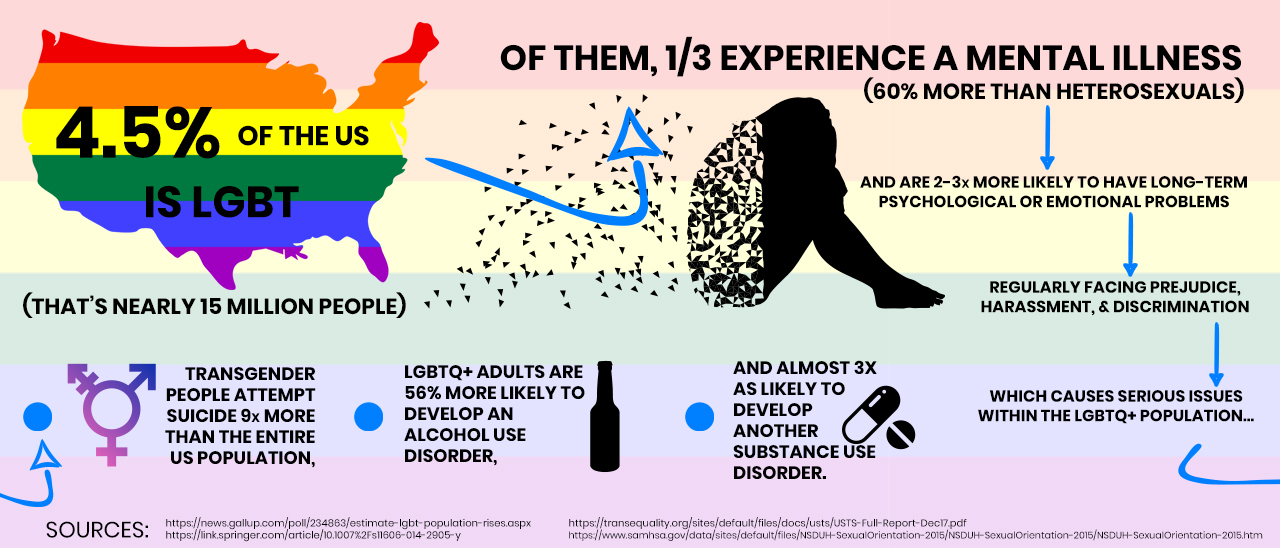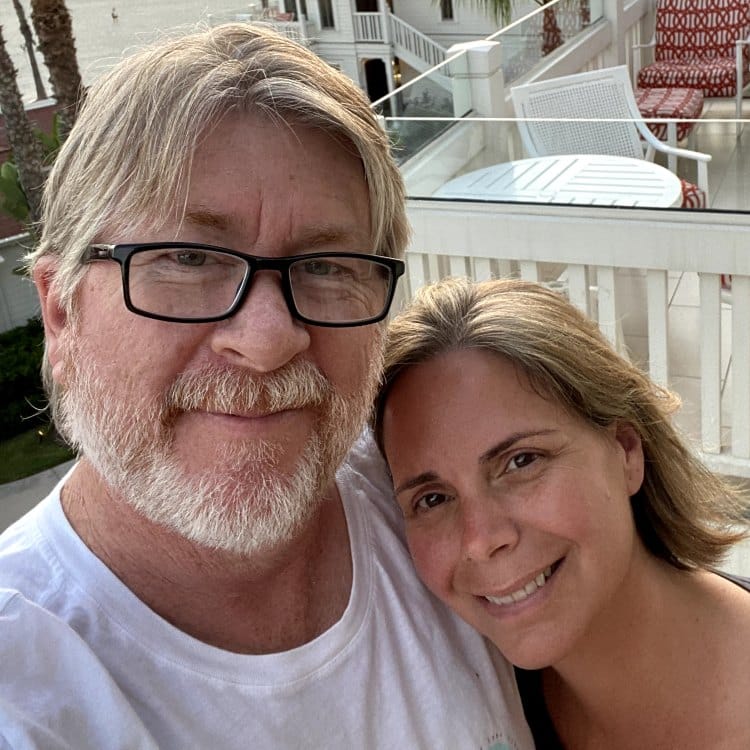Those who identify as a different sexual orientation or gender than the majority of the population are a part of the LGBTQ+ community; LGBTQ+ stands for lesbian, gay, bisexual, transgender, queer, and more. The LGBTQ+ community faces various challenges that can sometimes create mental health issues or substance abuse disorders.
It is important to understand that identifying with the LGBTQ+ community is not a mental illness itself. However, many members of the LGBTQ+ community, particularly younger members, experience mental health issues and substance abuse disorders due to the discrimination, shame, and traumatic events they experience 1.
Members of the LGBTQ+ community are at high risk of experiencing this discrimination, shame, and trauma. Thankfully, with a supportive family and community, someone who identifies as LGBTQ+ can overcome adversity. In fact, individuals in the LGBTQ+ community utilize mental health services at 2.5 times the rate straight individuals do 2.
It is essential to understand the LGBTQ+ community, the challenges that affect this community, and the mental health issues and substance abuse disorders that can occur. It is also imperative to explore the available and ideal treatment options for members of this community.

LGBTQ+ Statistics
Demographics
Based on over 340,000 interviews conducted by Gallup in 2017, 4.5% of the United States population identifies as lesbian, gay, bisexual, or transgender. This percentage is an increase from 4.1% in 2016 and 3.5% in 2012 3.
The percentage of those who identify as LGBT decreases as age increases. The jump is particularly high between Millennials (born between 1980 and 1999) and Generation X (born between 1965 and 1979), as 8.2% of millennials identify as LGBT, and only 3.5% of Generation X identify as LGBT 3.
In 2017, more women identified as LGBT than men:
5.1% of women
3.9% of men
This gap is much more significant than it was in 2012 when 3.5% of women and 3.4% of men identified as LGBT 3.
The adverse and sometimes traumatic events that LGBTQ+ individuals experience throughout their lifetime can create long-lasting effects. Many times these individuals will develop mental health issues as a result of these painful experiences.
According to a survey of 3,453 diverse LGBTQ adults done by Robert Wood Johnson Foundation 4:
- 57% of those who identify as LGBTQ+ have experienced slurs relating to their sexual orientation or gender identity.
- 53% of LGBTQ+ have experienced similar insensitive or offensive comments.
- 57% of LGBTQ+ people reported that they or their LGBTQ+ friends or family members have been threatened or non-sexually harassed.
- 51% said that they or their LGBTQ+ friends or family members have been sexually harassed or experienced violence.
- 34% of LGBTQ+ individuals have said that they or their LGBTQ+ friends or family members have been harassed verbally while in a bathroom or have been asked if or told that they were using the wrong bathroom.
- 20% of people who identify as LGBTQ+ reported being discriminated against because of their sexuality or gender identity.
- 22% of LGBTQ+ people have reported similar discrimination when being considered for a promotion and when trying to rent or buy a living space.
Mental Health Issues
Those who identify as LGBTQ+ are subject to health disparities resulting from societal stigma, discrimination, and the denial of their human and civil rights. This discrimination is associated with high rates of substance abuse, psychiatric disorders, and suicide 5.
LGBTQ+ individuals often experience violence and victimization, which causes long-term effects. The level of acceptance they receive from themselves, their families, and their society dramatically affects their mental health and safety 5.
People who identify as gay, lesbian, or bisexual are two to three times more likely to have long-term psychological or emotional issues than heterosexual people 6:
5.2% of heterosexual men and 6% of heterosexual women report psychological or emotional issues.
10.9% of homosexual men report psychological or emotional issues.
15% of bisexual men report psychological or emotional issues.
12.3% of homosexual women report psychological or emotional issues.
18.8% of bisexual women report psychological or emotional issues.
A member of the LGBTQ+ community dealing with discrimination, inadequate treatment, and a lack of support is not unusual. These unpleasant and detrimental experiences can lead to depression, anxiety, Post Traumatic Stress Disorder (PTSD), and in some extreme cases, suicide 7.
Depression
Young people who identify as LGBTQ+ are much more likely to experience depression than young individuals who do not identify as LGBTQ+.
A survey conducted through 2016-2017 identified that 28% of LGBTQ+ youth, 40% of which are transgender, expressed feelings of depression most or all of the time in the past month. Only 12% of their heterosexual peers expressed similar feelings in the past month 9.
A study conducted in 2015 found that 60% of LGBTQ+ youth said that they stopped engaging in some of their regular activities due to feelings of extreme sadness or hopelessness 9.
Another study conducted in 2015 identified that 1.9 million LGBTQ+ adults experienced a major depressive episode in the past year (18.2% of all LGBTQ+ adults) , including 1.4 million (13.1% of all LGBTQ+ adults) who had a major depressive episode with severe impairment 10.
The study found that LGBTQ+ adults were much more likely to have had a major depressive episode in the past year than their heterosexual counterparts. Only 6.2% of heterosexual adults experienced just the major depressive episode, and 3.9% had a major depressive episode with severe impairment 10.
Anxiety
Almost all of the research on the topic of LGBTQ+ mental health suggests that individuals in this community experience much higher anxiety levels because of the discrimination and prejudice they are regularly subjected to 11.
The high rates of lack of social acceptance, workplace discrimination, and housing discrimination can make it extremely difficult for LGBTQ+ individuals to feel safe in their communities. An extreme lack of security can easily lead to feelings of anxiety surrounding friendships, income, and housing opportunity 11.
Between 30% and 60% of LGBTQ+ individuals experience anxiety symptoms at some point in their lifetime. This rate is 1.5 to 2.5 times higher than the rate at which their heterosexual or gender-conforming counterparts experience anxiety 12.
Some of the most common issues among LGBTQ+ youth manifest in the form of anxiety disorders. A total of 12% of young LGBTQ+ girls experience symptoms of anxiety, as do 16% of young LGBTQ+ boys 13.
Post Traumatic Stress Disorder (PTSD)
The social challenges and related traumatic events that LGBTQ+ individuals experience creates an elevated prevalence of PTSD in people who identify as LGBTQ+ compared to their heterosexual counterparts 14.
It is important to note that LGBTQ+ individuals who experience moderate, increasing mistreatment and high, consistent mistreatment are at a higher risk for developing PTSD than LGBTQ+ individuals who experience low levels of decreasing mistreatment 15.
One study concluded that those who have had same-sex partners throughout their lifetime had higher PTSD rates than those who identify as heterosexual and have had no same-sex partners 14.
Suicide
Members of the LGBTQ+ community regularly encounter prejudice, harassment, or discrimination. Negative feelings towards an LGBTQ+ individual may even lead to bullying, victimization, social isolation, and violence. In the worst-case scenario, these events can lead to thoughts of suicide, attempted suicide, and carried out suicide 16.
Young people in the LGBTQ+ community are over two times as likely to have thoughts of suicide and are over four times as likely to attempt suicide when compared to heterosexual young people.
Furthermore, a third of transgender young people have seriously considered suicide, and 1 in 5 of them have made a suicide attempt 9.
A total of 40% of the transgender population has attempted suicide in their lifetime, which is almost nine times the attempted suicide rate of 4.6% among the entire United States population. Additionally, 48% of those who identify as transgender have considered suicide in the last year, and only 4% of the U.S. population reports similar considerations 17.
Substance Use Disorders/Addiction
Dealing with mental health issues and harmful attitudes within social groups can cause LGBTQ+ community members to seek out drugs and alcohol as a form of relief. LGBTQ+ individuals are much more likely to binge drink, smoke, and use drugs than their heterosexual counterparts 7.
Two studies have found that adults who identify as LGBTQ+ were more likely than those who do not identify as LGBTQ+ to have a substance use disorder in the past year 10, 18:
15.1% of LGBTQ+ adults had an alcohol or drug use disorder in the past year.
7.8% of heterosexual adults had an alcohol or drug use disorder in the past year.
20-30% of LGBTQ+ individuals abuse substances throughout their lifetime.
9% of the general population has similar substance abuse issues.
Tobacco
Members of the LGBTQ+ community use tobacco products 200% more than their heterosexual peers 18. Additionally, young people who identify as LGBTQ+ are more likely to report using tobacco products than young people who do not identify as LGBTQ+ 19.
Take a look at statistics below between two studies done in 2016.
Youth who have used electronic nicotine products (e-cigarettes) 19, 20:
36.5% — lesbian, gay, bisexual individuals
26.5% — transgender individuals
18.1% — straight individuals
Individuals who have used smoked over 100 cigarettes 19, 20:
47.5% of lesbian, gay, and bisexual individuals
44.6% of transgender individuals
41.4% of straight individuals
Individuals who are current cigarette smokers 19, 20:
21.8% of lesbian, gay, and bisexual individuals
21% of transgender individuals
14.6% of straight individuals
Alcohol
Adult members of the LGBTQ+ community, including young adults and adults aged 26 or older, are more likely to drink alcohol and develop an alcohol use disorder than their heterosexual counterparts 10.
A study conducted in 2015 reviewed the drinking habits of adults in the LGBTQ+ community over the past month of their lives, comparing them to non-LGBTQ+ adults. Below is what they found.
Compared to non-LGBTQ+, all LGBTQ+ adults 18 years and older had a 10:
7.4% higher rate of drinking
9.4% higher rate of binge drinking
1.1% higher rate of heavy alcohol usage
Compared to non-LGBTQ+ female adults, LGBTQ+ female adults had a 10:
13.1% higher rate of drinking
16.8% higher rate of binge drinking
3.6% higher rate of heavy alcohol usage
Compared to non-LGBTQ+ male adults, LGBTQ+ male adults had a 10:
1.2% higher rate of drinking
0.9% higher rate of binge drinking
1.3% lower rate of heavy alcohol usage
They also found that 10.8% of all LGBTQ+ adults had an alcohol use disorder in the past year — compared to 6.1% in the heterosexual adult population.
Looking at these numbers we can infer that the differences in alcohol drinking habits among females are much greater between LGBTQ+ and non-LGBTQ+ than the differences between males.
Marijuana
Adult members of the LGBTQ+ community, including young adults and adults aged 26 or older, are also more likely to use marijuana and develop a marijuana use disorder than their heterosexual counterparts 10.
A 2015 study analyzed marijuana smoking habits of the past year between heterosexual adults and LGBTQ+ adults. Here’s what they found.
Among LGBTQ+ adults 10:
27.1% had used marijuana
3.9% had a marijuana use disorder
Among heterosexual adults 10:
16.2% had used marijuana
1.3% had a marijuana use disorder
Among young LGBTQ+ adults 10:
46.2% had used marijuana
7.4% had a marijuana use disorder
Among young heterosexual adults 10:
31% had used marijuana
4.9% had a marijuana use disorder
Methamphetamine
LGBTQ+ adults, including young adults and adults aged 26 or older, use methamphetamine at a much higher rate than their heterosexual counterparts.
In 2015, 2.3% of LGBTQ+ adults had used methamphetamine in the past year, compared to 0.6% of heterosexual adults 10.
Treatment Options
Members of the LGBTQ+ community may be hesitant to get help for mental health issues or a substance use disorder because of the lack of available resources and the stigma surrounding how they choose to identify.
Fortunately, there are addiction treatment programs that focus on needs specific to the LGBTQ+ population and welcome members of the LGBTQ+ community with open arms and a catered rehabilitation plan. Our Outpatient Rehab Center in San Diego specializes in the treatment of LGBTQ+ individuals. We also focus on co-occurring mental health issues to ensure the healing and recovery of each individual.
If you or a loved one is struggling with mental health issues or a substance use disorder, now is the time to seek treatment. Remember, you are not alone, and there is a treatment center that will meet your specific needs.
Contact Health Life Recovery or check out LGBTQ+ rehab program for help today.

Medically Reviewed By:
Dr. Sanjai Thankachen
Dr. Sanjai Thankachen graduated from Adichunchanagiri Institute of Medicine in 2000. He completed his residency in psychiatry in 2008 at Creedmoor Psychiatric Center in New York. Dr. Thankachen is currently working with Pacific Neuropsychiatric Specialists in an outpatient practice, as well as working at multiple in-patient psychiatric and medical units bringing his patients the most advanced healthcare treatment in psychiatry. Dr. Thankachen sees patients with an array of disorders, including depression, bipolar illness, schizophrenia, anxiety, and dementia-related problems.

Edited for Clinical Accuracy By:
Sean Leonard, Psychiatric Nurse Practitioner
Sean Leonard is a board-certified psychiatric nurse practitioner. He received his master’s degree in adult geriatric primary care nurse practitioner from Walden University and a second postmaster specialty in psychiatry mental health nurse practitioner from Rocky Mountain University. Sean has experience working in various diverse settings, including an outpatient clinic, inpatient detox and rehab, psychiatric emergency, and dual diagnosis programs. His specialty areas include substance abuse, depression, anxiety, mood disorders, PTSD, ADHD, and OCD.
Sources
- 1. Mental Health America. (n.d.). LGBTQ Communities and Mental Health. Retrieved August 17, 2020, from https://mhanational.org/issues/lgbtq-communities-and-mental-health
- 2. Platt, L. F., PhD, Wolf, J. K., BA, & Scheitle, C. P., PhD. (2017, May 16). Patterns of Mental Health Care Utilization Among Sexual Orientation Minority Groups. Retrieved from https://www.tandfonline.com/doi/abs/10.1080/00918369.2017.1311552
- 3. Newport, F. (2018, May 22). In U.S., Estimate of LGBT Population Rises to 4.5%. Retrieved from https://news.gallup.com/poll/234863/estimate-lgbt-population-rises.aspx
- 4. Robert Wood Johnson Foundation. (2019, June 12). Discrimination in America: Experiences and Views. Retrieved from https://www.rwjf.org/en/library/research/2017/10/discrimination-in-america–experiences-and-views.html
- 5. Office of Disease Prevention and Health Promotion. (n.d.). Lesbian, Gay, Bisexual, and Transgender Health. Retrieved August 17, 2020, from https://www.healthypeople.gov/2020/topics-objectives/topic/lesbian-gay-bisexual-and-transgender-health
- 6. Elliott, M. N., PhD, Kanouse, D. E., PhD, Burkhart, Q., MS, Abel, G. A., PhD, Lyratzopoulos, G., MD, Beckett, M. K., PhD, . . . Roland, M., DM. (2014, September 05). Sexual Minorities in England Have Poorer Health and Worse Health Care Experiences: A National Survey. Retrieved from https://link.springer.com/article/10.1007/s11606-014-2905-y
- 7. McMillen, M. (2011, August 26). Lesbian, Gay, Bisexual, and Transgender (LGBT) Teens and Stress. Retrieved August 17, 2020, from https://teens.webmd.com/features/lgbt-teens-and-stress#1
- 8. Center for Disease Control and Prevention. (2017, June 21). LGBT Youth. Retrieved from https://www.cdc.gov/lgbthealth/youth.htm
- 9. Human Rights Campaign Foundation. (n.d.). MENTAL HEALTH AND THE LGBTQ COMMUNITY. Retrieved August 17, 2020, from https://suicidepreventionlifeline.org/wp-content/uploads/2017/07/LGBTQ_MentalHealth_OnePager.pdf
- 10. Medley, G., Lipari, R. N., Bose, J., Cribb, D. S., Kroutil, L. A., McHenry, G., . . . RTI International. (2016, October). Sexual Orientation and Estimates of Adult Substance Use and Mental Health. Retrieved August 17, 2020, from https://www.samhsa.gov/data/sites/default/files/NSDUH-SexualOrientation-2015/NSDUH-SexualOrientation-2015/NSDUH-SexualOrientation-2015.htm
- 11. O’Grady, K., E.D., & The LGBT Center Orange County. (2020, January 07). Why Does The LGBT Community Experience Such High Levels Of Anxiety? Retrieved from https://www.anxiety.org/lgbtq-anxiety-depression
- 12. Brenner, B., PhD. (n.d.). Understanding Anxiety and Depression for LGBTQ People. Retrieved August 17, 2020, from https://adaa.org/learn-from-us/from-the-experts/blog-posts/consumer/understanding-anxiety-and-depression-lgbtq
- 13. Jenco, M. (Ed.). (2020, August 14). Studies: LGBTQ youths have higher rates of mental health issues, abuse. Retrieved from https://www.aappublications.org/news/2018/04/16/lgbtq041618
- 14. Alessi, E. J., Meyer, I. H., & Martin, J. I. (2013, March). PTSD and Sexual Orientation: An Examination of Criterion A1 and Non-Criterion A1 Events. Retrieved from https://www.ncbi.nlm.nih.gov/pmc/articles/PMC4477838/
- 15. Stiles, L. (2018, December 17). Harassment of LGBT Youths Can Lead To Lasting Depression, PTSD. Retrieved from https://www.psychiatryadvisor.com/home/topics/anxiety/ptsd-trauma-and-stressor-related/harassment-of-lgbt-youths-can-lead-to-lasting-depression-ptsd/
- 16. Chicago Lakeshore Hospital. (2017, January 18). Understanding Addiction and Mental Illness in the LGBTQ Community. Retrieved from https://www.chicagolakeshorehospital.com/blog/addiction-mental-illness-lgbtq-community
- 17. National Center for Transgender Equality. (2016, December 17). The Report of the 2015 U.S. Transgender Survey. Retrieved from https://transequality.org/sites/default/files/docs/usts/USTS-Full-Report-Dec17.pdf
- 18. Hunt, J. (2012, March 9). Why the Gay and Transgender Population Experiences Higher Rates of Substance Use. Retrieved from https://www.americanprogress.org/issues/lgbtq-rights/reports/2012/03/09/11228/why-the-gay-and-transgender-population-experiences-higher-rates-of-substance-use/
- 19. Johnson, S. E., PhD, O’Brien, E. K., PhD, Coleman, B., PhD, MPH, Tessman, G. K., MA, Hoffman, L., MPH, & Delahanty, J., PhD. (2019, August 1). Sexual and Gender Minority U.S. Youth Tobacco Use: Population Assessment of Tobacco and Health (PATH) Study Wave 3, 2015–2016. Retrieved from https://www.ajpmonline.org/article/S0749-3797(19)30192-8/fulltext
- 20. Hoffman, L., Delahanty, J., Johnson, S. E., & Zhao, X. (2018, May 12). Sexual and gender minority cigarette smoking disparities: An analysis of 2016 Behavioral Risk Factor Surveillance System data. Retrieved from https://www.sciencedirect.com/science/article/pii/S0091743518301646

Social Attitudes